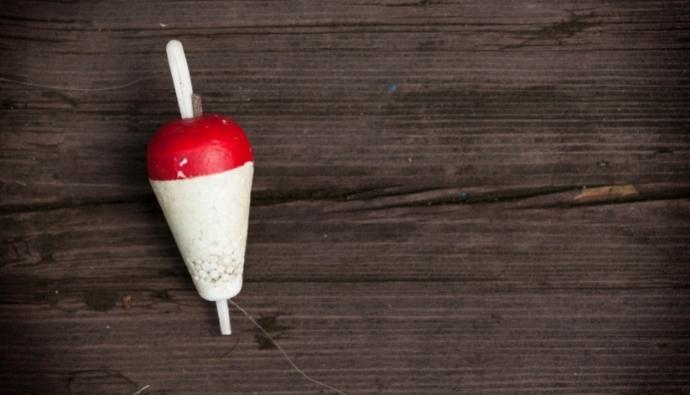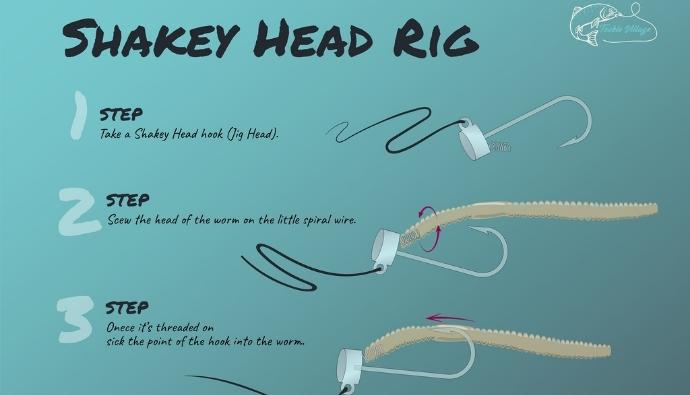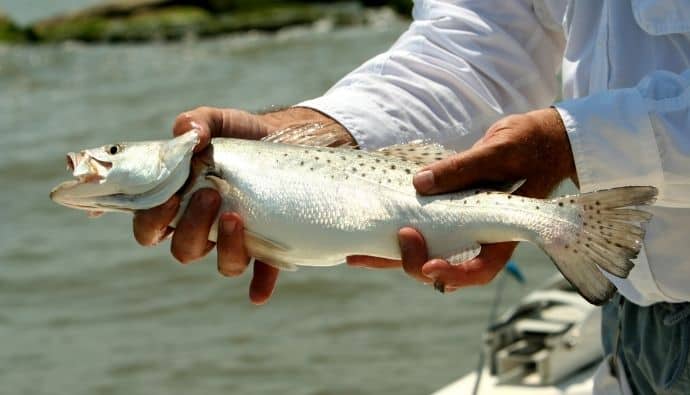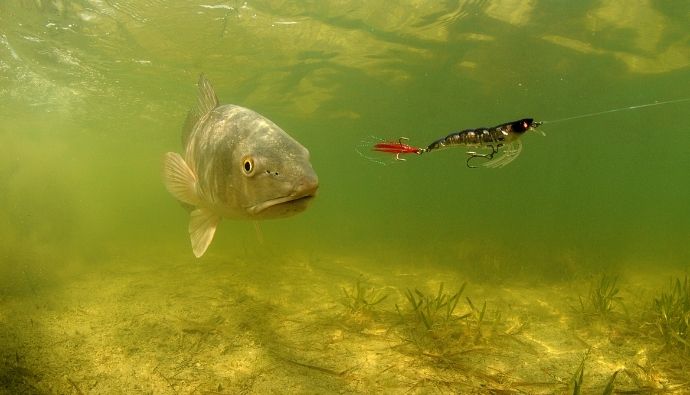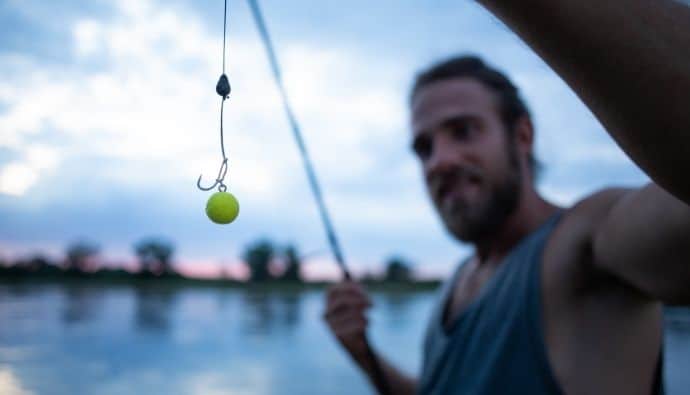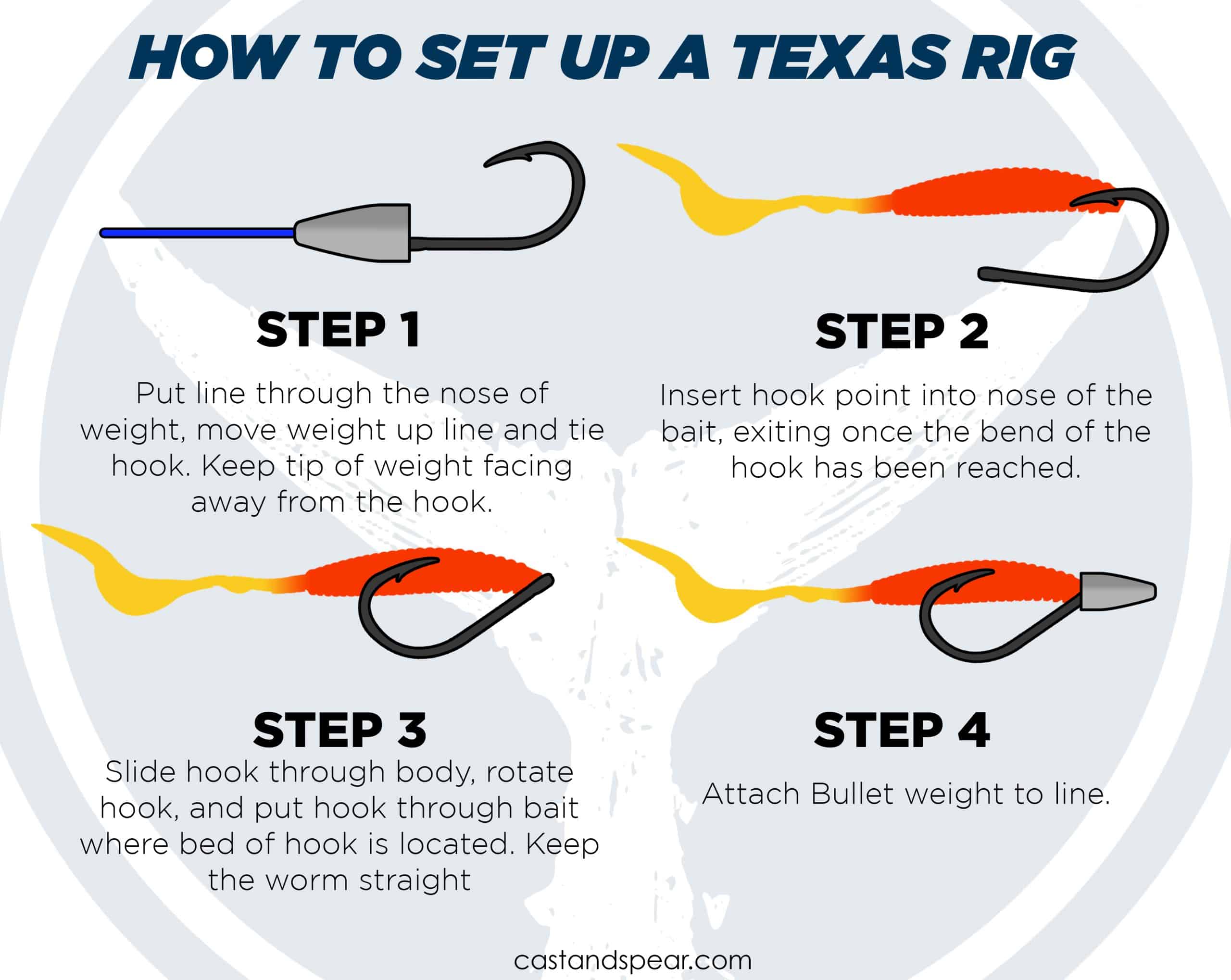
If you are having trouble catching redfish or speckled trout, then check out the popping cork rig. This is a three to five inches long float that is made from either hard plastic or Styrofoam.
Anglers can set up the rig above their fishing line and cast it over a spot where they can find big fish such as bluefish and largemouth bass. When you yank the rod, the setup will start to pop loudly (thus the name) to catch their attention, and the lure or rig is dangling above it making them swim right up to the line.
Want to consistently catch inshore fish? You need to know how to fish a popping cork. So to help you, here’s how to go popping cork fishing! Once you’re done reading the article, you’ll be able to start catching fish with your cork rig!
How to Rig a Popping Cork
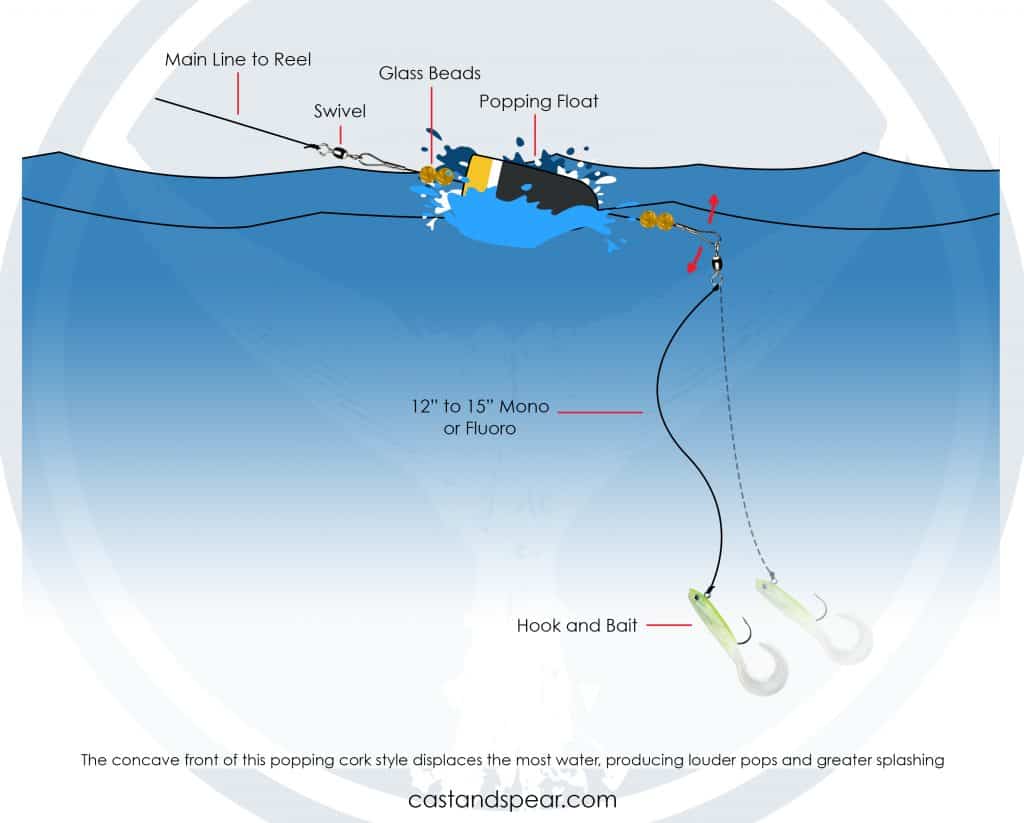
To start your popping cork fishing journey, it’s important to learn how to rig a popping cork.
You need to tie your leader to the popping cork you choose. All you need to do is link your mainline to the top i.e., the side of the cork that isn’t weighted, using a Palomar knot.
The leader material should be tied to the weighted end of the popping cork via a Trilene knot or equivalent. We like to use 15 to 20-pound fluorocarbon. It is strong enough to pull in-game fish such as snook, redfish, trout, and tarpon.
When to Use Popping Corks
Popping corks have unique concave tops that make a loud popping noise when they are retrieved. These will work well for any fish that is looking up towards the surface and are exceptionally efficient in shallow saltwater.
They are also useful for night fishing or if you are fishing around tangled covers such as docks and mangrove roots that hide fish. The noise the popping cork makes can lure them right out of cover and to your bait or lure.
Popping corks are also ideal to use in choppy water that is two to six feet deep. This includes sand bars alongside channel edges, around docks, piers, and over or near flooded grass flats. When you cast the rig into the water, the bait will sink and sit just below the float in ideal conditions.
However, choppy water can lift the bait and make it float alongside the popping cork. If that happens, you should use a split shot halfway down the line to the hook.
What Bait to Use With a Popping Cork
A popping cork can be used efficiently with a wide range of bait, both natural as well as artificial. These include sardines, minnows, shrimp, mullet, pinfish, menhaden, among others. If you are fishing during high tide, use dead and strip baits instead. The flow of the water will make them active and irresistible to the fish.
If you prefer artificials, you can use streamer flies, artificial shrimp, spoons, sinking plugs, and jigs. Try multiple lures or several hooks below the popping cork to attract doubleheaders on fish such as redfish and speckled trout. Jigs with a paddle or curly tails, weighted swimbaits, and plastic shrimp are top lures for popping corks.
Popping Cork Rigging Tips
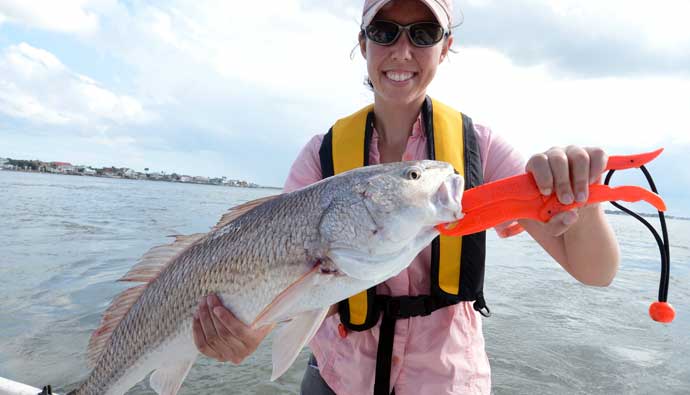
- Popping corks with concave tops make a little more noise and move more water compared to others.
- Use heavy-duty popping corks with bendable wire and large beads to attract bigger fish. Try to recreate a similar sound to what pogies and mullet make on the surface.
- The length of your fishing leader will depend on how deep the water is. In shallow water, you can use a line that is 18 inches and four feet for deeper water. Longer than that, and you will have difficulty casting.
- If you use baitfish, let them swim and give the popping cork a few tugs once in a while. This will make a commotion on the water to attract fish up to the surface. The bait will do the rest.
- Weighted corks can increase your casting distance. If you are using an unweighted setup, you can cinch a split shot to the leader right under the popping cork or on the stem of the rig.
- Since these corks float aggressively on the water, you should use grubs, tails, or plastic shrimp rather than live bait, especially if you are fishing in the shallows. These can remain on a light jig head better compared to fragile natural bait. Plus, since artificial bait is usually bite-size, fish can take them in a single strike.
- If you’re fishing for large game fish, you know how aggressive it can get. That’s because you have to recreate the sound of a large fish feeding to attract them. They will get lured in with the promise of food or by thinking the sound is of fish fighting for food even if they aren’t hungry. To attract them in with the popping cork, make it pop once followed by a pause and repeat this throughout the retrieval. The single pop will sound more natural.
- Do not work the rig too fast, and if you think you are doing it too slowly, slow down some more. Strikes occur during the pauses, and aggressive retrievals will deter attacks. When the popping cork submerges, start winding steadily but quickly till the fish runs off the reel, and you know you have it hooked.
- Don’t rig a popping cork too close to the line, or it may slide up and put pressure on the knot and pop off completely.
- If your popping cork has worn down and cannot maintain its position, double up the line.
- Corks that have clips or slits attached to the leader can be adjusted easily in position. If you are fishing off the bottom and it drops to four feet, you can adjust the depth of the bait quickly.
- If you are fishing in murky conditions, use popping corks that have beads and metal cork rods. These make a lot of noise, which will come in handy during night fishing or in low light conditions.
Fishing with Natural Bait Using Popping Cork Rigs
When it comes to popping corks fishing, there are two ways with which you can use natural bait such as shrimp with this setup – casting or trolling. The primary purpose is to attract fish to the bait using sound. Do that by lowering the rod tip while pointing at the popping cork and then jerking it up and down to make it pop.
Experiment with the time between pops to determine what works best. If fishing in shallow water, the bait will stay lively for a shorter time than if you are fishing in deep water.
If you are drifting your boat or fishing from the shore, you can use a minnow under the cork without popping it. The slow movement should be enough to entice strikes, provided the bait does not get stuck in grass or debris. Use a split shot to prevent this from happening and make it ride up to the surface where it may be snatched up by birds.
Why and How Do Popping Cork Rigs Catch Fish?
A popping cork rig lures big fish in by creating a sound like that of a frenzy feeding on the water’s surface. Moreover, it stimulates the movement of prey fleeing, thus attracting the attention of game fish.
You have to put the popping cork in a place where fish will possibly be around. Afterward, pull roughly on the rod once or twice to enable the float to make a loud popping sound. It will be followed by splashes on the water’s surface. Then, leave the bait dangling a couple of feet at the bottom of the water.
After the first popping sound, pause for a while. Pop the cork again once or twice after a few seconds by quickly flicking the rod tip. Stop for a moment, then do the same thing as you reel the rig in the area where your target will most probably strike. If you’re not getting any bite, simply retrieve the rig and then recast.
When the fish finally strikes, the popping cork goes underneath. Hence, it also serves as a strike indicator. The important thing to remember is to avoid slack in the line; otherwise, it will result in missed hooks! Watch closely, so you can make rapid turns as soon as the cork is pulled. When you miss the hook, just cast again in the same zone.
The retrieve pace and the loud pops are crucial in attracting your target fish. Bluefish and Big jacks fall more easily through thick and deep chugs that drive significant amounts of water and create the loudest popping sound. You can adjust the speed and sound based on the fish you want to catch.
The Different Types of Popping Corks
Cigar Popping Corks
These popping corks are ideal in clear and windy conditions when fish are more skittish, and a large splash may scare them off. It is narrower compared to others, which makes them more aerodynamic.
Cupped Popping Corks
These are ideal for use in murky fishing conditions. The cupped portion of these popping corks makes a lot of noise, which is perfect in dirty conditions when fish are reliant on senses other than sight.
Egg Shaped Popping Corks
These popping corks are the biggest you can get and are ideal if you are using live bait or big lures.
Weighted and Unweighted Popping Corks
If you want to cast long distances, use weighted popping corks. These also settle upright quickly compared to the unweighted popping corks. The latter only ends upright when the lure or bait is pulled.
Frequently Asked Questions
Attach the Gulp! Shrimp through the head and out through the top or the bottom, exposing the hook.
The only time you can use corks in the surf is if the water is entirely calm and only in back bays and sounds. Calm lakes and river beds can offer ideal conditions for this setup to work.
Yes, but ultimately, it is how you work it that will determine whether you attract a big catch or scare every fish in the vicinity away. Using cork to attract bites is not cheating. You are just improving your chances of strikes, and just because you have this setup doesn’t mean you will get bit on your first cast. The tips above can help you improve your fishing game, but there is a lot of experimentation involved, especially when trying to figure out how many times you should pop.
And that’s it! We hope our article has helped you catch fish with a popping cork rig.




 Facebook
Facebook YouTube
YouTube